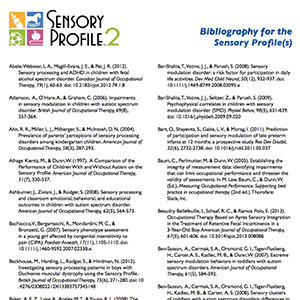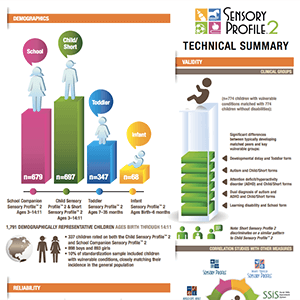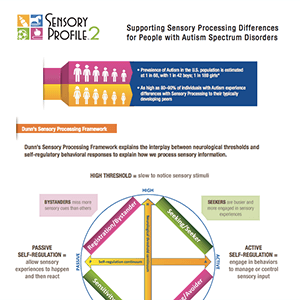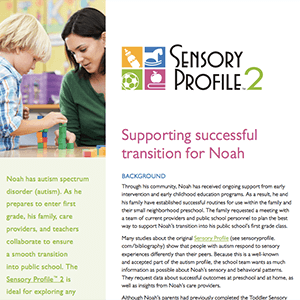Discovering strengths within sensory processing patterns
Sensory processing patterns come in all forms, and can make living in a world full of constant noise, movement, and changes in environment a very difficult place to thrive. What we may see as a simple walk through a bustling town to do some sightseeing could be a barrier for someone who processes that environment as an overwhelming dose of chaos.
Our tools can help you support your clients to discover new ways to cope with the external stimuli around them on a daily basis.
Helping your clients recognise their trigger points and identifying ways to overcome them is often the key to long-term success, and we’ve gathered a wide array of resources to assist you, as you guide them to attaining a better understanding of their own sensory processing.
Exploring products
Sensory Profile™ 2
The SP-2 family of assessments provides you with standardised tools to help evaluate a child's sensory processing patterns in the context of everyday life
Adolescent/Adult Sensory Profile
A self-questionnaire for evaluating sensory processing patterns in teens and adults
Sensory Processing Measure
The SPM-2 helps you gain a complete picture of sensory functioning at home, at school, and in the community, across the lifespan
Additional resources
Sensory Profile 2 author video FAQ
- Question #1: Isn’t it better to complete the Sensory Profile 2 with the teacher or parent?
- Question #2: How is it possible for a child to have more than others’ scores on multiple sensory patterns?
- Question #3: Some of the strategies for supporting a child are the same for HIGH or LOW sensory pattern scores; what does that mean?
- Question #4: What’s up with some of the Registration items on the Toddler Sensory Profile 2?
- Question #5: Do you support people from other disciplines administering the Sensory Profiles?
- Question #6: How do I deal with two different classroom teachers giving me different scores on the School Companion?
Author case study series: Winnie Dunn, PhD, OTR, FAOTA — Sensory processing & impact on everyday life: case studies using the Sensory Profile 2
This 3-part webinar series by Sensory Profile-2 author Dr. Winnie Dunn uses case study examples to support health and education professionals to incorporate sensory processing knowledge into everyday practice.
This series has been provided with the support of Occupational Therapy Australia and is reproduced here with the permission of Occupational Therapy Australia.
- Case study 1: Using the Toddler Sensory Profile 2 to support a 2 1/2 year old whose family are requesting help with hygiene and meal-time.
- Case study 2: Using the Child Sensory Profile 2 to support a 5 year old who lives in a rural location and needs to be able to participate in car journeys with her family.
- Case study 3: Using the School-Companion Sensory Profile 2 to support a child in third grade who is becoming more socially isolated.

Sensory processing and challenging behavior: a study using the Sensory Profile 2 and BASC-2
Evan Dean, PhD
Dr. Evan Dean discusses the relationship between sensory processing and challenging behavior using the findings from research conducted with the Sensory Profile 2 and Behavior Assessment System for Children, 2nd Edition (BASC-2)

Meet the author
Winnie Dunn, PhD, OTR, FAOTA
Sensory Profile author Winnie Dunn has led a full life, both professionally and personally. Learn more about the author of Sensory Profile 2 test and how it came to be

Sensory Profile 2 bibliography
A detailed bibliography for the Sensory Profile products

Sensory Profile 2 technical summary
An informative infographic about the Sensory Profile 2 standardisation sample including demographic, reliability and validity information

Supporting Sensory Processing infographic
An infographic on Supporting Sensory Processing Differences for People with Autism Spectrum Disorders

Sensory Profile 2 case study: supporting a successful transition for Noah
A case study highlighting one child’s successful transition into a mainstream year two class in the US

Sensory Profile 2 sample reports
View sample Sensory Profile 2 reports generated from Q-global

Q-global® training
Learn how to access and use Q-global, our web-based platform for test administration, scoring, and reporting

Situating sensory processing concepts with other approaches
Watch this pre-recorded author presentation talking about how the different sensory approaches compare to each other

